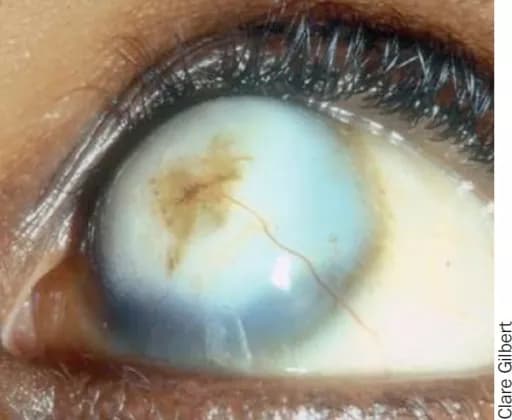What are the other Names for this Condition? (Also known as/Synonyms)
- Night Blindness
- Vitamin A Deficiency causing Keratomalacia
- Xerotic Keratitis caused by Keratomalacia
What is Keratomalacia? (Definition/Background Information)
- Keratomalacia is a disorder affecting the eyes, which is caused by vitamin A deficiency. Vitamin A deficiency can affect a variety of organs in the body including the eyes
- Vitamin A is important for the optimal growth of the skin, bone, mucus membranes of the stomach, intestine, and reproductive tract
- Vitamin A is required to maintain the normal epithelium of cornea and conjunctiva. There is dryness of the cornea and conjunctiva with secondary ulceration and bacterial infection in Keratomalacia
- The common signs and symptoms of Keratomalacia include night blindness, excessive dryness of the eyes, and corneal wrinkling. In case of complications, the condition may lead to blindness and corneal infection
- Keratomalacia is treated through vitamin A replacement and eye drops to prevent eye dryness. With appropriate treatment and aggressive replacement of vitamin A, the prognosis is generally improved
Who gets Keratomalacia? (Age and Sex Distribution)
- Keratomalacia can occur in individuals of any age group; however, the condition is predominantly observed in infants and young children
- The condition is observed in both males and females; there is no gender preference
- The condition is more prevalent in certain developing countries where vitamin A deficiency is more common
What are the Risk Factors for Keratomalacia? (Predisposing Factors)
Risk factors associated with Keratomalacia include:
- Infants and pre-schoolers living below poverty line
- Malnourished people
- Alcoholics
- Individuals who are pure vegans
- Consumption of a diet poor in vitamin A (such as skimmed milk rather than whole milk)
- Individuals who suffer from fat malabsorption, inflammatory bowel diseases
- Those who have undergone small bowel surgery
It is important to note that having a risk factor does not mean that one will get the condition. A risk factor increases ones chances of getting a condition compared to an individual without the risk factors. Some risk factors are more important than others.
Also, not having a risk factor does not mean that an individual will not get the condition. It is always important to discuss the effect of risk factors with your healthcare provider.
What are the Causes of Keratomalacia? (Etiology)
Keratomalacia is an ocular disorder that is caused by the dietary deficiency of vitamin A. This condition is caused by taking ‘vitamin A poor foods’ such as:
- Beto carotene rich foods such as green leafy vegetables, orange-colored fruits and vegetables
- Retinoid rich foods such as liver and eggs
This deficiency disorder can also occur when the body is unable to absorb beta carotene and retinoids, or when the body is unable to convert beta carotene and retinoids to vitamin A.
What are the Signs and Symptoms of Keratomalacia?
The signs and symptoms of Keratomalacia include:
- Night blindness, which is poor vision in dim or poor light (especially at nights)
- Xerophthalmia - extreme dryness of the eyes
- Wrinkled cornea; progressive softening of the cornea and corneal cloudiness
- Grey deposit on the delicate membrane covering the whites of the eyes
This disorder is bilateral and it affects both the eyes.
How is Keratomalacia Diagnosed?
The diagnosis of Keratomalacia may involve:
- Complete evaluation of medical history along with a thorough physical examination
- Eye examination and vision test
- Colour blindness test
- Laboratory measurement of serum retinol levels
Many clinical conditions may have similar signs and symptoms. Your healthcare provider may perform additional tests to rule out other clinical conditions to arrive at a definitive diagnosis.
What are the possible Complications of Keratomalacia?
The possible complications associated with Keratomalacia include:
- Blindness
- Corneal infection
- Corneal rupture (perforation)
How is Keratomalacia Treated?
The treatment for Keratomalacia typically involves:
- Aggressive vitamin A replacement therapy
- Antibiotics to prevent infections in the fragile cornea
- Usage of eye drops for dry eyes
- Augmenting the diet with vitamin A, beta carotene, and retinoid. This can gradually help arrest the corneal and lacrimal gland damage
How can Keratomalacia be Prevented?
Keratomalacia is a preventable disorder that can be prevented by including the following in one’s diet:
- Foods (fruits and vegetables) that are rich in beta carotene that includes green leafy vegetables (broccoli, spinach), cantaloupe, sweet potatoes, apricots, palm oil, and carrots
- Foods that are rich in retinoids such as liver, eggs, and fish
Children diagnosed with measles must have adequate vitamin A rich foods, since they are at an increased risk for Keratomalacia.
What is the Prognosis of Keratomalacia? (Outcomes/Resolutions)
- Usually in Keratomalacia, there is ulceration of the cornea that occurs rapidly and this generally affects both the eyes. The ulceration can cause the loss of corneal thickness, which can result in corneal perforation. If this is not treated aggressively, this can lead to blindness
- With appropriate early treatment and proper replacement of vitamin A, the prognosis is generally improved
Additional and Relevant Useful Information for Keratomalacia:
The following DoveMed website link is a useful resource for additional information:
Related Articles
Test Your Knowledge
Asked by users
Related Centers
Related Specialties
Related Physicians
Related Procedures
Related Resources
Join DoveHubs
and connect with fellow professionals


0 Comments
Please log in to post a comment.